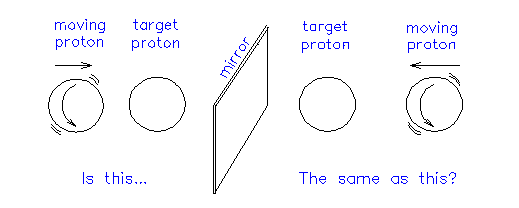
OF
TRIUMF Experiment 497
"Measurement of the Flavour Conserving Hadronic Weak Interaction"
OR
"Parity Violation in pp Scattering at 221 MeV"
Most people are familiar with the long range forces of gravity and electromagnetism.
For example, they have noticed things
clinging together because of "static electricity", they have played
with magnets, and they know that things are pulled to the
earth by gravity.
There are, however, two other important forces that are not so widely
known because they act only over very short distances,
much smaller than an atom. These short-range forces are usually called
simply the strong nuclear force and the weak
nuclear force. They are vital to our world. For example, the nuclei
of atoms themselves are held together by the strong force,
and the fusion reactions which power the sun and stars are possible
only because of the weak force.
The TRIUMF cyclotron produces beams of protons. Some sub-atomic particles
can feel only the weak force, but protons
experience both the strong and the weak forces. In the Parity Experiment,
we are interested in the effects of the weak force
between protons.
In our experiment, we take a beam of protons from the TRIUMF cyclotron
and pass it through 400 mm of liquid hydrogen.
Hydrogen is 99.95% protons by weight. As the protons from the cyclotron
pass through the liquid hydrogen, about 4% of
them will be deflected from their straight-line path. This deflection
is almost completely due to the strong nuclear force
between the protons in the beam and the protons in the target. Nevertheless,
the weak nuclear force is present too, and affects
the result. We want to measure the effect of the weak force in the
presence of the strong force which is something like ten
million times as strong.
The secret to accomplishing this difficult task is that the strong nuclear
force "conserves parity" and the weak nuclear force
does not. What this means is that if we change our experiment to its
mirror image, the part of the force between the protons
which arises from the strong force will not change but the part due
to the weak force will. The weak nuclear force is said to
"violate parity".
Spinning objects like tops or gyroscopes tend to resist changes in the
direction of the axis of their spins. This propery is called
the "angular momentum" of the object. Since the proton has this property,
we refer to a "proton spin" pointing in the
direction of the apparent axis of the spin. In our experiment, we alternate
between the case where the proton spin is pointed
along the direction of motion (like a right handed screw, spinning
clockwise looking at the target) and the case where the
proton spin is pointed opposite to the direction of motion (like a
left handed screw). These two cases are mirror images of
each other, as shown in the sketch below. Because the protons can feel
both the strong and weak forces, we find that the
number of protons that is deflected is increased by a small amount
(by about one part in 10^7) in the right handed case, and
is decreased by the same small amount in the left handed case.

Our goal is to measure the difference between the right-handed and left-handed
cases very precisely. This will test various
theoretical models of the interaction and will help us to learn more
about the weak interaction between particles which
mainly feel the strong nuclear force.
Finally, the rather formal title of E497, "Measurement of the Flavour
Conserving Hadronic Weak Interaction", deserves a
word of explanation. Particles such as the proton, which feel the strong
force are called "hadrons". Since E497 is concerned
with the effects of the weak force between two particles which also
experience the strong force, it can be said to be interested
in the "weak hadronic interaction". Hadrons are made of quarks. There
are six kinds of quarks -- up, down, charm, strange,
top and bottom -- referred to as the six quark "flavours". One thing
the weak interaction is able to do, but that no other
interaction can do, is to change one flavour of quark into another.
For example, in order for the Sun to fuse four hydrogen
atoms together to make an atom of helium, it has to turn four protons
into two protons plus two neutrons. This is done by the
weak interaction changing the flavour of the quarks in two of the protons.
In E497, we are interested in a case where the
weak interaction does not change the flavour of the quarks. It is "flavour
conserving". Hence the "flavour conserving
hadronic weak interaction" is the weak interaction between two particles
which also feel the strong force and in which none
of the quarks change to any other kind of quark.
Des Ramsay